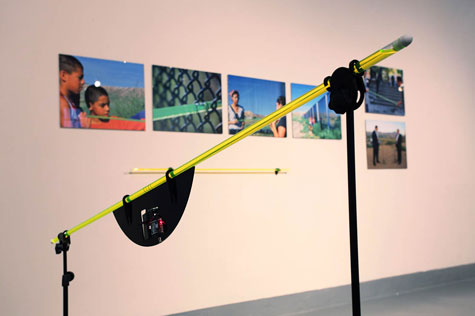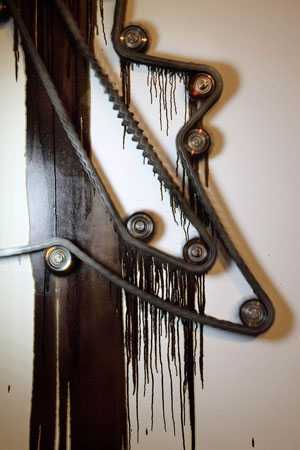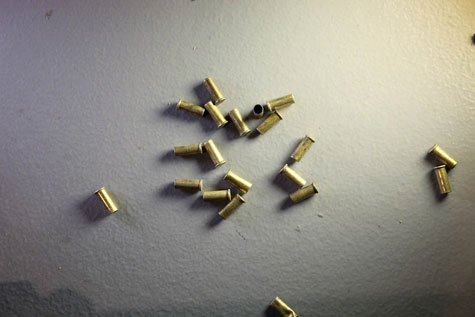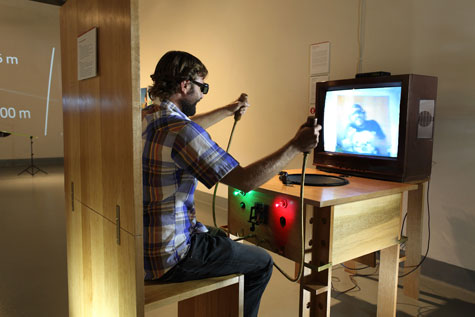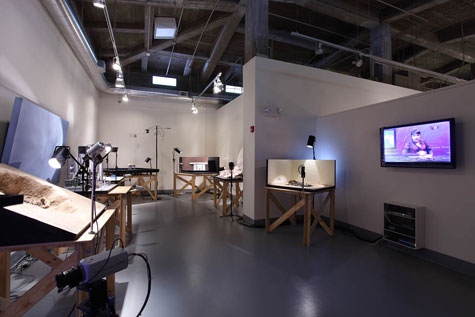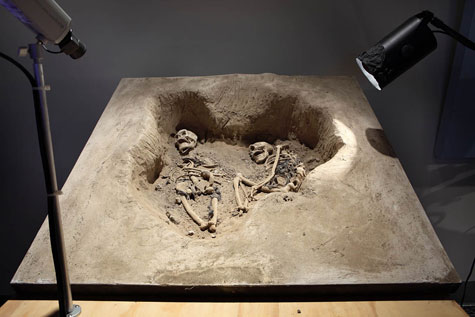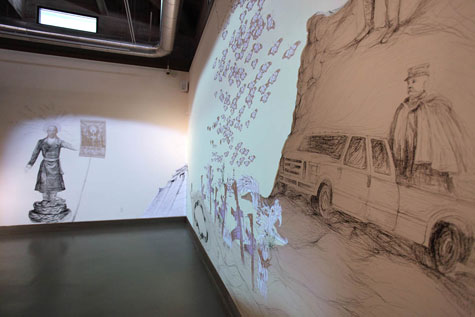This year marks the centennial of the Mexican Revolution and the bicentennial of Mexico’s independence. In commemoration, curators Kerry Doyle and Karla Jasso have assembled Contra Flujo: Independence and Revolution, an exhibition focused on Mexican artists working in the midst of a more contemporary revolution—a technological one.
“We were thinking of a show looking at what types of revolutions were happening in contemporary art,” says Doyle, assistant director of the Rubin Center at the University of Texas at El Paso. “New-media artworks break stereotypes about what Mexican art is,” she says. She adds that many people think of Mexican art primarily as an expression of folklore.
Contra Flujo also works to challenge widely held assumptions about technology and its role in the art gallery. In 2010, many complain that personal interaction has been cheapened as traditional written and oral communication methods become increasingly rare. This exhibition demonstrates that new-media art can engage the senses—physical movement, touch, smell, sound—in new and effective ways.
Each of the seven artists participating in Contra Flujo lives and works in Mexico City. Together, they spent three weeks in El Paso installing their work with the help of students from UTEP and the Universidad Autónoma de Ciudad Juárez. The extra hands helped with the additional labor required to install such a technology-driven show while fulfilling the Rubin Center’s mission to provide for student-artist exchange, building relationships and creating learning opportunities.
“It certainly stretched our capabilities as a staff to install a show like this,” Doyle says.
On the Saturday afternoon I visited Contra Flujo, Ivan Abreu’s Cross Coordinates was experiencing technical difficulties. The sculptural aspect of the work, a carpenter’s level fitted with a device designed to transmit data to a projector, had an electrical short. Ideally, two visitors would each hold one end of the level, working together to achieve balance while the projection on the nearby gallery wall reflected their progress.
The Rubin Center staff fixed the work the following Monday, after some troubleshooting with the artist, but this brief failure drove home the point of one of the overarching themes of this exhibition—Mexico is in a fragile state, and the relationship between the United States and Mexico is broken. But “Cross Coordinates” ultimately communicates a message of collaboration and hope. Video and photographs document powerful members of the local community (such as the president of UTEP and the former rector of UACJ, and businessmen Paul Foster, president and CEO of Western Refining, and Miguel A. Fernandez, president of Strategic Plan Juárez) balancing Abreu’s level. The artist also documents citizens of Mexico and the United States working together to achieve balance through the metal rungs of the border fence.
All of the artists in Contra Flujo contribute politically informed work, but Marcela Armas’ are the most overtly political works in the exhibition. At the same time, her art pushes the limits of new media and engages visitors’ senses in unusual ways.
I-Machinarius, a system of functioning gears and chains arranged in the upside-down outline of Mexico, continually drips and splashes crude oil down the white gallery wall and onto the floor. The pungent scent of the oil and the grinding sound of the motor powering the gears fill the gallery space. Armas created I-Machinarius in 2008, shortly after President Felipe Calderón pushed to privatize Mexico’s oil industry, even though the country’s constitution dictates that natural resources are the property of the nation.
Although Armas’ Resistencia/Resistance (2009) is a new-media piece, the artist uses a long-established, commonplace technology, employing the same kind of wire used to heat toasters. Installed in a separate room built into the main gallery space, Armas’ wire begins to glow bright red as soon as a visitor steps into the room. It forms the shape of the U.S.-Mexico border and is supported by nonheated wires stretching from what would be the interior of each country. The tension from the inside holds the hot wire of the border in place. It’s simple, effective metaphor, and the concepts and visceral experiences created by both I-Machinarius and Resistencia/Resistance make for attention-grabbing yet smart political artworks.
Armas isn’t the only artist in Contra Flujo to move beyond mere sight to engage viewers with a political message. Sound is integral to the work of both Rogelio Sosa and Gilberto Esparza. Sosa presents Un-Balance 2010, a sound piece that mashes up gunshots and sirens (recorded on everyday devices such as cell phones) with poetry by Gabriela Jauregui and speeches by Mexican President Calderón. The violent cacophony greets visitors as soon as they enter the Rubin Center.
Esparza uses sound more subtly. For Remenante/Remainder (2010) Esparza crafted a device suspended from the ceiling that drops .22 caliber shell casings at random intervals. Each bullet represents a drug-war-related death in Mexico that occurred during the three months preceding the installation of the work. The distinctive ping of each bit of spent ordnance as it hits the ground and bounces across the floor serves as an eerie reminder of the drug-fueled violence taking place not far from the gallery. The label for Remenante/Remainder features a quote from Esparza: “…the shell casing gives evidence of the continuous circulation of arms…the trafficking of which points to the United States as a provider and Mexico as a consumer.”
For a few hours on Wednesday and Friday afternoons, Arcángel Constantini’s contra <~> flujo/Against the Flow connects viewers on each side of the U.S.-Mexico border. (One half of the work is located in the Rubin Center, the other in a studio at UACJ.) In order to fully engage the artwork, a device that resembles something from a steam-punk convention, a visitor must sit on a wooden perch facing a screen with a large speaker in front of it. A participant in both El Paso and Juárez grasps a Nintendo Wii wand which has been altered to become a copper-covered baton and then flips a switch. The screen in El Paso shows electrical current entering the body of the person holding the wand in Juárez. At the same time, the participant in Juárez controls the audio blaring from the speaker and the current flowing through the viewer in the Rubin Center gallery.
Constantini took inspiration for “contra <~> flujo/Against the Flow” from the street vendors in Mexico who frequent cantinas and bars, selling small electric jolts to drinkers who try to see who can withstand the current the longest. Here, the shock reminds the participant that what happens on one side of the border yields repercussion on the other. In Constantini’s work, responsibility is unavoidable—the consequences of one person’s actions are immediately evident.
The remaining works in this exhibition use technology to alter or distribute images, calling attention to its effects on national identity and public opinion. Ivan Puig’s Lider de Opinión/Opinion Leader (2008) critiques the power of the Mexican media to form public opinion. The first part of his installation resembles a living room with two chairs and a television set. The monitor shows a news broadcast, and visitors who take the time to watch the entire video loop will notice that the anchor reads three entirely different stories about the same recurring images, which include an oil refinery, a hospital nursery and human skeletons. A look behind the living room wall reveals that the images from the newscast are actually shots of models in the gallery captured on video by closed-circuit cameras. With Lider de Opinión/Opinion Leader, Puig challenges his viewers to consider that seeing should not always lead to believing.
Laura Valencia’s Carbón Negro, Hueso Blanco/Black Coal, White Bone, a lyrical work that combines graphite and charcoal wall drawings with projected animations, recalls the mural tradition of post-revolutionary Mexico. For this technologically updated version commissioned specifically for this exhibition, Valencia draws anachronistic figures and scenes from Mexican history as a backdrop for an animation by Lola Sosa. The animation brings bits and pieces of the stories referenced in Valencia’s drawings to life. Horses run along the Rio Bravo del Norte/Rio Grande, a military general in a historic uniform stands in the bed of a pickup truck, guns fall from the sky and butterflies migrate in and out of Mexico. Not unlike the way Puig questions the tendency of media images to shape public opinion, Valencia draws attention to the way that images and stories from a country’s history shape its identity.
Doyle says it was important to create an exhibition that allowed for dialogue between the artists and border residents. Much of the work in Contra Flujo must be experienced in person, often in tandem with another viewer. Through smelling, listening, looking, balancing, feeling and thinking, gallery visitors physically and mentally engage with this technology-driven, politically minded exhibition.
![]()
Theresa
Bembnister is a writer recently based in Marfa, Texas.


